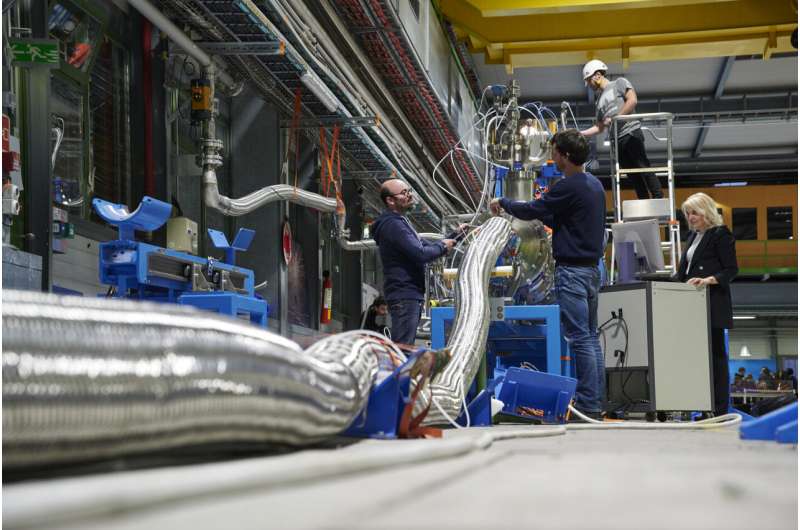Successful tests of a cooler way to transport electricity

Like a metal python, the huge pipe snaking through a CERN high-tech hall is actually a new electrical transmission line. This superconducting line is the first of its kind and allows vast quantities of electrical current to be transported within a pipe of a relatively small diameter. Similar pipes could well be used in towns in the future.
This 60-metre-long line has been developed for CERN's future accelerator, the High-Luminosity LHC, which is due to come into operation in 2026. Tests began last year and the line has transported 40,000 amps. This is 20 times more than what is possible at room temperature with ordinary copper cables of a similar size. The line is composed of superconducting cables made from magnesium diboride (MgB2) and offers no resistance, enabling it to transport much higher current densities than ordinary cables, without any loss. The snag is that, in order to function in a superconducting state, the cables must be cooled to a temperature of 25 K (-248°C). It is therefore placed inside a cryostat, a thermally insulated pipe in which a coolant, namely helium gas, circulates. The real achievements are the development of a new, flexible superconducting system and the use of a new superconductor (MgB2).
Having proven that such a system is feasible, at the end of March the team tested the connection to the room temperature end of the system. In the High-Luminosity LHC, these lines will connect power converters to the magnets. These converters are located at a certain distance from the accelerator. The new superconducting transmission lines, which measure up to 140 m in length, will feed several circuits and transport electrical current of up to 100,000 amps.
"The magnesium diboride cable and the current leads that supply the magnets are connected by means of high-temperature ReBCO (rare-earth barium copper oxide) superconductors, also a challenging innovation for this type of application," explains Amalia Ballarino. These superconductors are called "high-temperature" because they can operate at temperatures of up to around 90 kelvins (-183 °C), as opposed to just a few kelvins in the case of classical low-temperature superconductors. They can transport very high current densities, but are very tricky to work with, hence the impressiveness of the team's achievement.
Tests of the line with its new connection represent an important milestone in the project, as it proves that the whole system works correctly. "We have new materials, a new cooling system and unprecedented technologies for supplying the magnets in an innovative way," says Amalia Ballarino.
The project has also caught the attention of the outside world. Companies are using the work done at CERN to study the possibility of using similar transmission lines (at high voltage), instead of conventional systems, to transport electricity and power over long distances.
Provided by CERN





















